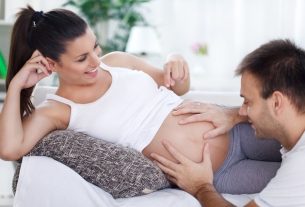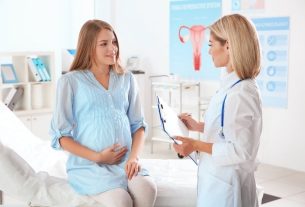In the 33rd week of pregnancy, all of the baby’s organs are already formed and the bones are more hardened, despite being softer and more flexible in the head, to facilitate passage through the vaginal canal during normal birth.
At this stage of pregnancy, most babies are already turned upside down, in the birth position. However, some babies may take a little longer, usually until the 37th week. Learn how to help your baby turn upside down.
During this week, the woman may continue to have Braxton-Hicks contractions, hemorrhoids, heartburn or a burning sensation in the stomach, and there may be pain in the lower back that radiates to the legs or excessive production of intestinal gases.

Baby development
In the 33rd week of pregnancy, the main milestones in the baby’s development are:
- The auditory system is almost complete, which allows you to distinguish the mother’s voice very clearly and calm down when you hear it;
- The baby is already used to the sound of the mother’s heart, digestion and voice and may be scared or jump at low sounds that he is unfamiliar with.
- All digestive enzymes are already present and if the baby is born now, it will be able to digest the milk;
- The amount of amniotic fluid has already reached its maximum limit and it is likely that this week the baby will already be turned upside down;
Furthermore, the baby’s bones are already fully developed, although still a little soft and malleable, especially those in the head, which remain flexible to facilitate the baby’s exit through the vaginal canal during normal birth.
Some areas of the skull bones, called fontanelles or fontanelles, will remain soft for up to a year after the baby is born to allow the brain to continue developing.
At this stage of pregnancy, if the woman is pregnant with twins it is likely that the due date is close, as in this case, most babies are born before 37 weeks, but despite this, some may be born after 38, although this is not very common.
Baby size and weight
The size of the baby at 33 weeks of gestation is around 42 centimeters measured from head to toe and around 30.2 centimeters from head to bottom, being equivalent to the size of a celery.
The baby’s weight this week is around 2.0 to 2.3 kg.
Changes in a woman’s body
In the 33rd week of pregnancy, a woman may feel low back pain that can radiate to the buttocks, thigh and leg, which occurs due to a change in the curvature of the spine, causing compression of the sciatic nerve, which begins at the end of the spine and passes through the glute and descends to the heel.
Additionally, symptoms of Braxton-Hicks contractions, heartburn or a burning sensation in the stomach, or swelling of the legs and feet, especially at the end of the day, may continue.
In this week of pregnancy, it is also common for women to present excessive production of intestinal gases, due to the size of the uterus, which can compress the intestine, making movements slower, or shortness of breath, which occurs due to compression in the lungs that are unable to release. expand as before pregnancy, making breathing difficult.
Care during the 33rd week
In the 33rd week of pregnancy, some precautions are important to help alleviate discomfort that may arise, such as:
- Dor and lumbar: apply hot compresses to your back, do not stand for a long time, when sitting you should avoid crossing your legs or using a pregnancy belt to support your belly and back, these can help improve back pain. Furthermore, excessive effort should be avoided, although absolute rest is also not recommended;
- Braxton-Hicks contractions: move the body, changing position, taking a light walk, or resting if the woman was very active when the contractions started. Additionally, drinking a glass of water, doing relaxation or deep breathing exercises, or taking a warm bath for up to 30 minutes can help ease the discomfort of contractions. However, if the contraction is strong, very frequent or accompanied by other symptoms, you should seek medical help immediately, as it could be labor. Know how to identify the signs of labor;
- Heartburn or burning sensation in the stomach: eat in small amounts at intervals of less than 2 to 3 hours, avoid eating or drinking up to 3 hours before bed, avoid drinks during meals, place the head of the bed higher and avoid consuming foods that stimulate heartburn such as fried foods, spicy foods or very spicy, can help alleviate this discomfort. See other tips on how to relieve heartburn during pregnancy;
- Hemorrhoid: Taking a sitz bath with warm water, using unscented wipes or washing the anal area after defecating can help alleviate the discomfort of hemorrhoids. Furthermore, not sitting or standing for a long time can help reduce the pressure that the belly puts on the rectum and prevent the development of hemorrhoids. See more tips on how to treat hemorrhoids during pregnancy.
- Excess intestinal gas: Avoid foods that stimulate gas production such as beans, cabbage, broccoli, cauliflower or Brussels sprouts, for example. In addition, you should keep your body hydrated by drinking at least 8 glasses of water a day, and eating foods rich in fiber such as fresh fruit and whole grain bread or cereals. Check out other tips on how to relieve excess gas during pregnancy;
- Swelling in the legs or feet: Practicing regular physical exercise, such as walking or swimming, as advised by your doctor, can help reduce this discomfort. It is also recommended not to stand for a long time, and place your feet higher than your body, supporting your feet when you need to sit. However, if the swelling does not improve, starts suddenly, or has swelling in the hands and face, you should seek medical help immediately, as it could be a sign of pre-eclampsia. Find out more about pre-eclampsia and how it is treated;
- Shortness of breathe: You should change position trying to stay as straight as possible to give your lungs a little more space to expand, and sleeping on your left side helps improve circulation, they can help improve this discomfort. However, if you experience intense shortness of breath, difficulty breathing, rapid or wheezing, chest pain, bluish lips or fingers, or numbness in your hands or feet, you should seek medical help as soon as possible or the emergency room at the earliest. next.
During pregnancy it is important to keep your body hydrated, drinking at least 8 glasses of water a day, as it helps to improve blood circulation and relieve symptoms of swelling in the legs and feet, heartburn and intestinal gas.
It is also important to have a balanced and nutritious diet, including foods rich in calcium such as milk or yogurt, as well as fresh fruit, for example, to provide the nutrients necessary for the baby’s healthy development. See what nutrition should be like during pregnancy.
Furthermore, it is important to follow medical recommendations, carry out prenatal consultations, take supplements recommended by the obstetrician and practice physical activities approved by the doctor, such as swimming, water aerobics or walking, to strengthen muscles and control weight gain during pregnancy. pregnancy.
Confirm which month of pregnancy you are entering your details here:
Bibliography
- AMERICAN PREGNANCY ASSOCIATION. 33 Weeks Pregnant. 2024. Disponível em: <https://americanpregnancy.org/healthy-pregnancy/week-by-week/33-weeks-pregnant/>. Acesso em 24 jan 2024
- KISERUD, T.; et al. The World Health Organization Fetal Growth Charts: A multinational longitudinal study of ultrasound biometric measurements and estimated fetal weight. PLoS Med. 14. 3; e1002284, 2017
- BLOTT, Maggie. Your pregnancy day by day. 2nd ed. São Paulo: Senac, 2011. 280.
- SULAK, O.; et al. Anatomical development of the fetal uterus. Early Hum Dev. 83. 6; 395-401, 2007
- LIDDLE, Sarah D.; PENNICK, Victoria. Interventions for preventing and treating low-back and pelvic pain during pregnancy. Cochrane Database Syst Rev. 2015. 9; CD001139, 2015
- KISERUD, T.; et al. The World Health Organization Fetal Growth Charts: A multinational longitudinal study of ultrasound biometric measurements and estimated fetal weight. PLoS Med. 14. 3; e1002284, 2017
- STAROSELSKY, A.; et al. Hemorrhoids in pregnancy. Can Fam Physician. 54. 2; 189-90, 2008
- AVSAR, AF; KESKIN, H.L Haemorrhoids during pregnancy. J Obstet Gynaecol. 30. 3; 231-7, 2010
- HO, Simone S.M.; YU, Winnie W.M.; LAO, Terence T.; et al. Effectiveness of maternity support belts in reducing low back pain during pregnancy: a review. Journal of Clinical Nursing. 18. 11; 1523-1532, 2009
- THE AMERICAN COLLEGE OF OBSTETRICIANS AND GYNECOLOGISTS. Back Pain During Pregnancy. Disponível em: <https://www.acog.org/patient-resources/faqs/pregnancy/back-pain-during-pregnancy>. Acesso em 27 jul 2021
- RICHTER, JE Review article: the management of heartburn in pregnancy. Aliment Pharmacol Ther. 22. 749–757, 2005
- VAZQUEZ, J. C. Heartburn in pregnancy. BMJ Clin Evid. 1411. 2015
- STATPEARLS (INTERNET). TREASURE ISLAND (FL): STATPEARLS PUBLISHING. Braxton Hicks Contractions. Available at: <https://pubmed.ncbi.nlm.nih.gov/29262073/>. Accessed on 27 Jul 2021
- LEE, Shih-Yi; et al. Dyspnea in pregnancy. Taiwanese Journal of Obstetrics and Gynecology. 56. 4; 432-436, 2017
- ESMAEILI, Muhammad; et al. Fontanel Size from Birth to 24 Months of Age in Iranian Children. Iran J Child Neurol. 9. 4; 15–23, 2015

Sign up for our newsletter and stay up to date with exclusive news
that can transform your routine!
Warning: Undefined array key "title" in /home/storelat/public_html/wp-content/plugins/link-whisper-premium/templates/frontend/related-posts.php on line 12
Warning: Undefined array key "title_tag" in /home/storelat/public_html/wp-content/plugins/link-whisper-premium/templates/frontend/related-posts.php on line 13




